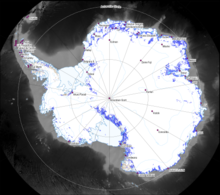| This article may be in need of reorganization to comply with Misplaced Pages's layout guidelines. Please help by editing the article to make improvements to the overall structure. (March 2019) (Learn how and when to remove this message) |

Blue ice occurs when snow falls on a glacier, is compressed, and becomes part of the glacier. During compression, air bubbles are squeezed out, so ice crystals enlarge. This enlargement is responsible for the ice's blue colour.
Small amounts of regular ice appear to be white because of air bubbles inside and also because small quantities of water appear to be colourless. In glaciers, the pressure causes the air bubbles to be squeezed out, increasing the density of the created ice. Water is blue in large quantities, as it absorbs other colours more efficiently than blue. A large piece of compressed ice, or a glacier, similarly appears blue.
The blue color is sometimes wrongly attributed to Rayleigh scattering, which is responsible for the color of the sky. Rather, water ice is blue for the same reason that large quantities of liquid water are blue: it is a result of an overtone of an oxygen–hydrogen (O−H) bond stretch in water, which absorbs light at the red end of the visible spectrum. So, water owes its intrinsic blueness (as seen after > 3 meters of penetration) to selective absorption in the red part of its visible spectrum. The absorbed photons drive vibrational (normally infrared) transitions.
Once blue ice is exposed to warmer air, cracks and fissures appear in surface layers, and break up the large blue crystals of dense, pure ice. Within hours these air filled fissures cloud the surface making the ice appear white. The blue colour will not be seen again until the ice breaks or turns over to expose ice which air could not reach. For example, lucky tourists at Tasman Glacier, New Zealand in January 2011 saw an iceberg roll over to reveal startling blue ice, kept from air by staying underwater for months since the iceberg calved.
Antarctic runways

Blue ice is exposed in areas of the Antarctic where there is no net addition or subtraction of snow. That is, any snow that falls in that area is counteracted by sublimation or other losses. Such areas are known as blue-ice areas. These areas have been used as blue ice runways (e.g. Wilkins Runway, Novolazarevskaya, Patriot Hills Base Camp) due to their hard surface, which is suitable for aircraft fitted with wheels rather than skis.
References
- Braun, Charles L.; Smirnov, Sergei N. (August 1993). "Why Is Water Blue?". J. Chem. Edu., 1993, 70(8), 612. Dartmouth College. Archived from the original on 2012-03-20. Retrieved 2013-12-22.
- Harvey, Eveline (14 January 2011). "NZ blue ice sighting an unexpected treat for tourists". The New Zealand Herald. Retrieved 21 September 2011.
- Laybourn-Parry, Johanna; Wadham, Jemma (2014-08-14). Antarctic Lakes. OUP Oxford. ISBN 9780191649325.
External links
- Glaciology of Blue Ice Areas in Antarctica
- "Blue Ice in Antarctica". lpi.usra.edu. Lunar and Planetary Institute.
| Glaciers | |||||||
|---|---|---|---|---|---|---|---|
| Types | |||||||
| Anatomy | |||||||
| Processes | |||||||
| Measurements | |||||||
| Volcanic relations | |||||||
| Landforms |
| ||||||
| Related | |||||||